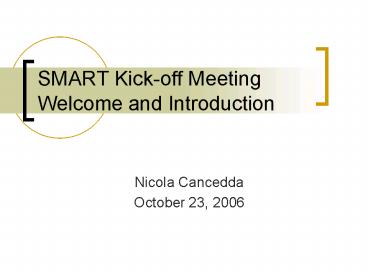SMART Kickoff Meeting Welcome and Introduction - PowerPoint PPT Presentation
1 / 14
Title:
SMART Kickoff Meeting Welcome and Introduction
Description:
Going beyond single-word translation and leveraging synergies with latent ... T6.1 Benchmarking of Machine Translation Technology. M1-30. Deliverable 6.2 ... – PowerPoint PPT presentation
Number of Views:53
Avg rating:3.0/5.0
Title: SMART Kickoff Meeting Welcome and Introduction
1
SMART Kick-off MeetingWelcome and Introduction
- Nicola Cancedda
- October 23, 2006
2
Motivation
- More than half of the citizens of the EU do not
speak a second language - Expanding global demand of tools for automatic
translation and cross-language retrieval,
clustering and categorization - Statistical approaches mainstream in research,
but still suffering from shortcomings, preventing
their diffusion - Many recent advances in ML are only starting to
hit the field
SMART is an attempt to solve identified
shortcomings of MT and CLTIA with the methods of
Statistical Learning
3
The SMART project
- Information Society Technologies Programme
- Sixth Framework Programme, Specific Target
Research Project (STReP) - Start date October 1, 2006
- Duration 3 years
4
The SMART Consortium
5
The SMART Consortium
6
Work-packages
- Scientific workpackages
- WP2 Advanced Statistical Translation Models
- WP3 Advanced Language Models
- WP4 Model Adaptation and Combination
- WP5 Cross-Language Textual Information Access
- WP6 Evaluation
- WP7 Dissemination and Exploitation
- WP1 Project Management and Co-ordination
7
WP2 Advanced Statistical Translation Models
- Going beyond phrase-based log-linear models in
SMT - T2.1 Characterization of current (SMT) approaches
- M1-12. Deliverable 2.1
- T2.2 Theoretical models of Markov-based
approaches - M1-12. Deliverable 2.1
- T2.3 Application of Markov Approaches to SMT
- M10-24. Deliverable 2.2
- T2.4 Efficient Implementation of Developed
Methods - M13-33. Deliverables 2.3, 2.4, 2.5.
8
WP3 Advanced Language Models
- Better LMs for improved translation fluency and
CLTIA - T3.1 Kernels for Language Models
- M1-12. Deliverable 3.1.
- T3.2 Learning Discriminative Language Models
- M7-21. Deliverable 3.2.
- T3.3 Integration with Translation Model
- M16-33. Deliverables 2.3, 5.3, 2.4, 5.4.
9
WP4 Model Adaptation and Combination
- Going beyond batch training to cope with data
scarcity and leverage user feedback - T4.1 Mixture-based Approaches for the Adaptation
of Translation Models - M1-33. Deliverables 4.1, 2.3, 5.3, 2.4, 5.4.
- T4.2 On-line Training Algorithms for Incremental
Training of Translation Models - M1-33. Deliverables 4.1, 2.3, 5.3, 2.4, 5.4.
- T4.3 Algorithms for achieving Domain and Genre
Independence via Model Combination - M1-33. Deliverables 4.1, 2.3, 5.3, 2.4, 5.4.
- T4.4 On-line Learning Algorithms for
Computer-Aided Translation - M1-33. Deliverables 4.2, 2.3, 5.3, 2.4, 5.4.
10
WP5 Cross-Language Textual Information Access
- Going beyond single-word translation and
leveraging synergies with latent-semantics
approaches - T5.1 Multilingual Lexicon Extraction
- M1-33. Deliverables 5.1, 5.3, 5.4.
- T5.2 Latent Language-Independent Analysis
- M4-33. Deliverables 5.2, 5.3, 5.4.
- T5.3 Model Adaptation and On-line Aspects of
CLTIA - M7-33. Deliverable 5.4.
11
WP6 Evaluation
- In-vitro and in-vivo testing
- T6.1 Benchmarking of Machine Translation
Technology - M1-30. Deliverable 6.2
- T6.2 User Evaluation of Adaptive MT Technology
- M1-12, 24-27, 33-36. Deliverables 6.1, 6.3.
- T6.3 Benchmarking of Cross-Language Textual
Information Access - M1-30. Deliverable 6.2.
- T6.4 User Evaluation of CLIR comprehension aids
- M1-12, 24-27, 33-36. Deliverables 6.1, 6.3.
12
WP7 Dissemination and Exploitation
- Making the best of it
- T7.1 Dissemination
- M1-36. Website. Scientific workshop.
- T7.2 Technology Watch
- M7-36. Techwatch (private) portion of the website
- T7.3 Exploitation Planning and IP Valorization
- M1-36. Deliverable 7.2.
- T7.4 Technology Demonstration and Showcasing
- M25-36. Deliverable 7.1. Business workshop.
13
Expected results and their use
- Scientific results
- Radically new research directions in SMT and
CLTIA - Incremental improvements in existing SMT and
CLTIA systems - Improvements in statistical learning methods by
facing new challenges in hard real-world tasks - Building conceptual bridges between all
involved communities - Dissemination
- Scientific workshop (See Task 7.1)
- Presentations to conferences and workshops
(including relevant evaluation events) - Journal articles
- Scientific portion of the website
14
Expected results and their use
- User results
- More usable SMT systems
- Performing better
- Adapting to new domains and over time
- Producing more fluent output
- Improved access to multilingual document
collections - CLIR potential eventually expressed via coupling
with comprehension aids - Exploitation routes
- Internal, through partners business units
- External, through technology licensing
- Non-scientist-oriented section of the project
website - Business-oriented workshop at the end of the
project (See Task 7.4) - Possibly publicly available showcase on the
WikiPedia scenario































